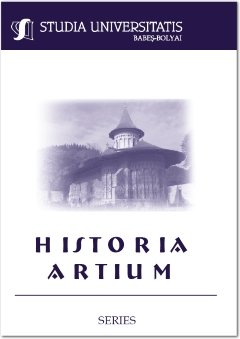UN ENGOLPION (“RELICHIA”?!) INEDIT ÎN ARHIVA SEMINARULUI DE ISTORIA ARTEI AL UNIVERSITĂŢII DIN CLUJ
AN UNPUBLISHED ENGOLPION (“RELICHIA”) FROM THE CLUJ UNIVERSITY’S ART HISTORY SEMINARY’S ARCHIVE
Author(s): Nicolae SabăuSubject(s): Fine Arts / Performing Arts
Published by: Studia Universitatis Babes-Bolyai
Keywords: Iconography; Engolpion; Relic; Mother of God (Théotokos); The Saviour; Tree of Jesse; Prophet Jonah; Iconoclasm.
Summary/Abstract: An Unpublished Engolpion (“Relichia”) from the Cluj University’s Art History Seminary’s Archive. The present paper represents an iconographic analysis of an engolpion, a small icon (pectoral medallion) worn by orthodox hierarchs, in order to have permanently near their heart Jesus and the Virgin Mary, as intercessors. The mentioned artifact is present only in the visual memory in two known photographs investigated by the first professor of art history at the University of Cluj, Coriolan Petranu, in 1929. The very summarized results of his investigation have determined us to further analyze this remarkable artifact. On the obverse there is a representation of the Virgin with the Child (Théotokos) sited in the center of a wreath in the shape of the Greek letter Ω and surrounded by 26 medallions made of vine wreaths displaying the busts of 16 prophets, 4 prophetesses and 6 crowned kings. In the lower part of the obverse there is a representation of the Tree of Jesse. The medallion’s reverse presents the figure of an enthroned Jesus, surrounded by 26 medallions referring to the New Testament: the four evangelists, the twelve apostles and 10 other saints. In the lower part there is a scene representing the moment the whale sets Jonah on land, a reference to Jesus’ premonition of his own Death and Resurrection. The present paper identifies the iconographic relation between this particular engolpion and late medieval reliquaries (Relichia), their history and symbolic message, between the eastern Ortodoxy and western Catholicism, the evolution and metamorphosis of the two themes as reflected by works in various media (small sculpture, monumental altarpiece sculpture, fresco, stainglass, silverworks etc), analogies with similar pieces, and it identifies a balcanic post-Byzantine model, probably from Mount Athos (17th-18th centuries), as suggested by the two Greek inscriptions on the engolpion, describing the two scenes.
Journal: Studia Universitatis Babes Bolyai - Historia Artium
- Issue Year: LVIII/2013
- Issue No: 1
- Page Range: 13-40
- Page Count: 28
- Language: Romanian

